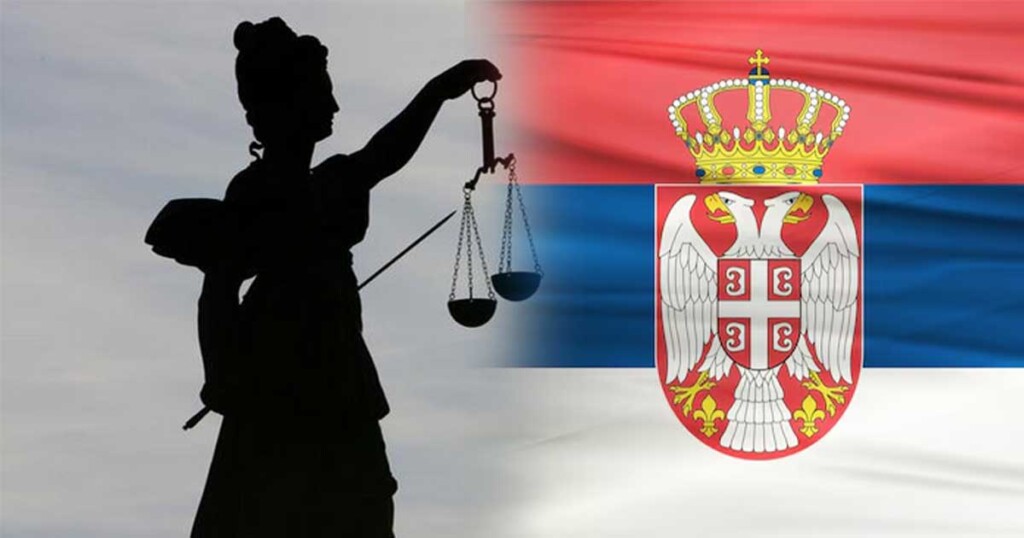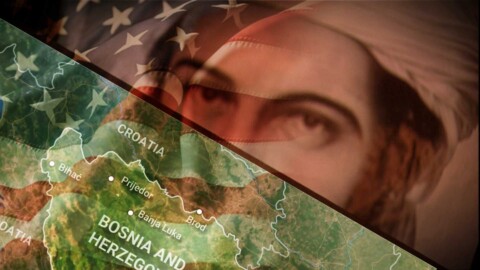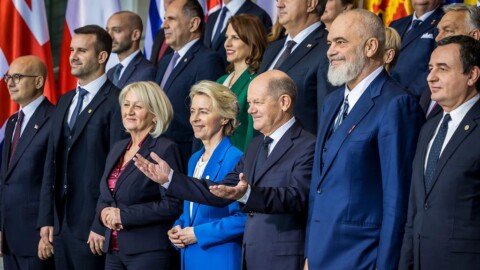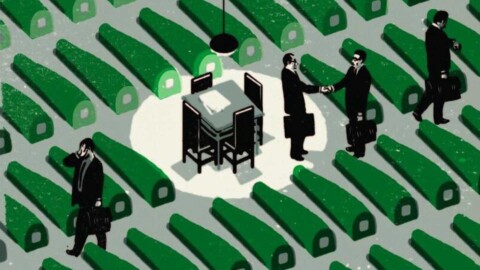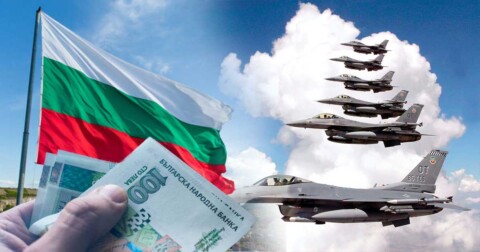The student protests have reignited the long-standing and controversial issue in domestic politics regarding the need to implement lustration within the state administration and judicial system of the Republic of Serbia.
Namely, as early as December of last year, MPs from the Ecological Uprising submitted to the National Assembly a draft Law on Responsibility for Human Rights Violations. On that occasion, the leader of this political movement, Aleksandar Jovanović Ćuta, stated that “it is time to finish what was not done on October 5, 2000.“
SETTLING SCORES IN THE NAME OF JUSTICE?
According to a survey by Belgrade-based Danas from late April this year, all pro-Western opposition political parties support the implementation of lustration following the electoral defeat of the “Progressives.”
For the president of the Democratic Party, Srđan Milivojević, lustration—which was never carried out in the 2000s—is now a key precondition for “a step forward out of the situation Serbia currently finds itself in,” as it represents “the settling of justice and restoring people’s faith that being honest is worth it.”
For Slobodan Cvejić of Zdravko Ponoš’s party Serbia Centre, only “the implementation of lustration at all levels can bring about any positive change”.
In the past, the promise to carry out lustration after the fall of Vučić’s regime was made by Marinika Tepić, as well as by the leader of the “Narodni pokret Srbija”, Miroslav Aleksić, while the “Pokret slobodnih građana” presented its own draft Law on Lustration back in 2020.
LUSTRATION – “MOTHER MARA”
At the very beginning of the student protests, just days before the “Ekološki Ustanak” presented its draft lustration law, former leader of “Demokratska stranka” and professor at the Faculty of Law in Novi Sad, Bojan Pajtić, advocated for the implementation of lustration “not only in political circles but also in the media”.
In March of this year, Branislav Grubački Guta, a member of the “Zeleno-levi front” in the Assembly of AP Vojvodina, stated that the resurgence of radical aesthetics was “utterly pathetic and obscure,” expressing hope “that students, along with the entire opposition-oriented civic public, will not only condemn it but also find a way to ensure such politically unacceptable practices are permanently eliminated from public space.”
In this context, Grubački concluded that “lustration is ‘Mother Mara’ for such organizations and individuals, and it will have to happen sooner or later”.
Recently, Veran Matić stated in a television interview that the failure to carry out lustration after October 5, 2000, is the main cause of Serbia’s current state.
Similarly, long-time Deutsche Welle correspondent and Danas columnist Nemanja Rujević recently proclaimed with exaltation that “the people’s wrath, the hand of justice, or some form of ‘lustration’ must, one fine day, reach all those who served the system and used it to elevate themselves above the people while trampling them underfoot.”
Otherwise, Rujević concludes, “it will all have been for nothing”.
“CLEAN HANDS” OF SAVO MANOJLOVIĆ
At the beginning of July, the political organization Kreni–Promeni and its leader Savo Manojlović announced the launch of a petition titled “Clean Hands,” aimed at obligating any future government that might come to power after the fall of the Progressives to conduct a “cleansing of the system from corrupt officials and individuals who participated in the persecution of their own citizens.”
Manojlović’s organization accompanied this initiative with a slogan that strongly echoes the tone of revolutionary declarations: “He who respected the law has nothing to fear. He who broke it has nothing to hope for”.
Judging by the statement from Radovan Novaković, a media-prominent Užice-based councilman and lawyer from the political group Užička Akcija, there are clearly supporters of lustration within local political parties as well.
Namely, Novaković told N1 television: “The time is coming when all those who engaged in crime and committed atrocities will be held accountable. But along with justice, something else is coming—lustration. A ban is coming for all those who are in politics today, who disgrace us and make criminal decisions in our name. A ban on them ever again engaging in politics—because if we don’t do that, we will soon be ruled by new Vučić, Dačić, and their children”.
BEHIND THE STUDENT PROTESTS
If the “unrealized Sixth of October,” as Igor Ivanović puts it, implies for the advocates of that political myth the fulfillment today of everything that Vojislav Koštunica and the DSS once prevented—and above all “political lustration”—then the renewed focus on the topic of lustration amid the student protests by numerous pro-Western political parties and public figures clearly points to a “Sixth of October” political agenda being carried by the fluid political structure emerging behind the student movement.
Although among Serbian patriots—who constitute the majority of the electorate and thus also the majority within the current civic protest—lustration is generally expected to mean some kind of decommunization, considering that Serbs, alongside Russians, were among communism’s greatest victims, the goal of the 2003 Law on Responsibility for Human Rights Violations—which was adopted but never implemented—was not to “cleanse” Titoist cadres from Serbia’s public administration and judiciary.
In examining the denazification-like nature of certain provisions in the 2006 Constitution of the Republic of Serbia, Marko Pavlović links the first lustration law from 2003 with the post-October 5 regime’s desire to purge alleged ultranationalist legacies from the Milošević era through a kind of self-denazification of “a society in which Nazism never existed,” all with the goal of “establishing a new totalitarianism—the totalitarianism of a multicultural paradise.”
In that context, Pavlović concludes:
“In Serbia, the law on lustration, that is, the Law on Responsibility for Human Rights Violations, was adopted on March 30, 2003. It included all cases of human rights violations occurring after March 23, 1976—the date when the International Covenant on Civil and Political Rights entered into force. The retroactive date was chosen as a compromise between the proponents of lustration (who demanded that the law cover the period of the ‘Milošević regime,’ from 1987 to 2000) and their opponents—the ‘legalists’ (who pointed to the communist dictatorship period from 1944 onward as the time of the most severe human rights abuses).”

EVERYTHING CONNECTED TO THE WARS OF THE 1990s
In reality, the Law on Responsibility for Human Rights Violations was aimed at removing individuals associated with the regime that preceded the October 5, 2000 overthrow. The law’s originally pro-Western author intended to “lustrate” a regime that had been characterized in the West as ultranationalist—or even fascist.
“The Lustration Law was not based on the idea of removing communist elements, but rather on the idea of denazifying the post-communist regime in Serbia”.
Current advocates of lustration also leave no doubt that it would primarily serve to purge the nationalist legacy of the 1990s. This is made entirely clear by Veran Matić’s recent statement that the failure to implement the lustration law in the 2000s resulted in the lack of “a serious break with the 1990s,” which is why “today we have war criminals who are somehow considered heroes”.
Green–Left Front MP and professor at the Faculty of Political Sciences, Đorđe Pavićević, also blames the failure to implement the 2003 law on the intention of certain circles to conceal “the state’s involvement in the war and potential charges for war crimes.”
Since Pavićević supports lustration—but only as one of several measures in the broader “process of purging power and institutions” after the fall of the Progressive regime—it is evident that, in his view, lustration should above all “cleanse” the public sphere of those connected to the wars of the 1990s, whom he had already labeled as the main culprits for the failure of lustration in the early 2000s.
RECKONING WITH THE GHOSTS OF THE PAST
A member of the political party that submitted the draft for a new lustration law late last year, Danijela Nestorović, speaks of the “ghosts of the past” who have survived in Serbian public life due to the lack of lustration after October 5, 2000. According to Bojan Pajtić, “Serbia is the only country that allowed tyranny to return within just ten years,” primarily because lustration was not carried out after October 5.
Whether lustration is seen as a tool for “cleansing” state institutions of the wartime and “nationalist” legacy of the 1990s, or as a reckoning with a returning tyranny, in both cases the adoption of a new lustration law primarily entails the legal enforcement of the Western propaganda narrative about the supposedly strong nationalist, militarist, and anti-democratic traditions of the Serbian people—traditions that must be eradicated in the process of European integration.
Just as the reference to the “morality of a democratic society” in Article 46 of the Serbian Constitution—rather than the more typical “public morality” used in comparative constitutional law—served the purpose of “negating the allegedly autocratic and ultranationalist morality of the ‘Milošević regime”.
ESTABLISHING “TRANSITIONAL JUSTICE”
To understand the true motivation behind pro-Western political actors’ support for lustration, it is important to consider the guidelines from the United Nations Development Programme (UNDP) document on the vetting of public officials in post-conflict environments, published in 2006.
According to this UN agency’s manual—whose overwhelmingly largest funders in 2024 were Germany and the United States—lustration is not associated with decommunization, as Serbian patriots often mistakenly believe, but rather with institutional reform of the public administration in countries emerging from conflict.
In this document, lustration is actually described as one of the measures for establishing “transitional justice,” through which the suitability of individuals for public service is assessed.
Personnel integrity is primarily to be judged based on past compliance with relevant human rights standards, with the goal of removing from public administration and political life those individuals who violated these standards during periods of conflict.
Since this UNDP codification of lustration norms was created during the post–Cold War era of unipolarity, the broad correlation it draws between lustration and “universally accepted” human rights standards reflects the Western policy of instrumentalizing human rights for the purpose of limiting the sovereignty and jurisdiction of nation-states—ultimately laying the groundwork for the establishment of a global pseudo-empire.
WAR GAINS OF THE COLLECTIVE WEST
Driven by this political motivation, the Collective West in those years promoted the principle that “the way a government treats its own people becomes a matter of international law,” and that, accordingly, the so-called international community “recognizes governments and states only if they comply with international human rights norms.” In this way, human rights, in the hands of Western liberal neocolonialism, became “a key value for shaping the world,” and consequently “the main rhetorical and ideological weapon in the first humanitarian wars during the Clinton era”.
In this context, it must always be remembered that the first “humanitarian” wars of the 1990s were waged specifically against the Serbs in Republika Srpska and the Federal Republic of Yugoslavia. The political processes that unfolded in the Serbian national space after the end of these wars aimed primarily at the post-conflict stabilization of the region, in order to permanently secure the war gains of the Collective West and its Balkan satellites.
Post-conflict stabilization of the region is also the official priority goal of Serbia’s EU accession process, as defined by the Stabilization and Association Agreement.
If the Collective West defined lustration during the era of unipolarity as a measure of “transitional justice” in post-conflict situations, then today’s push by local pro-Western political actors to implement lustration in Serbia is directly linked to concluding the process of post-conflict stabilization of the so-called Western Balkans — precisely as that stabilization appears through the lens of the Collective West’s strategic interests.

IN CORRELATION WITH THE PLANS OF GEOPOLITICAL ADVERSARIES
Accordingly, the legal sanctioning of the Western propaganda narrative about the criminal and tyrannical nature of the 1990s regime—which is portrayed as solely responsible for the wars over the Yugoslav legacy, and which implies an obligation for the self-denazification of Serbian society—appears to be, in the case of lustration, a higher priority for the Collective West than the personal purging of staff from the state administration and judiciary, which is a necessary but politically secondary consequence of such a measure.
If the Collective West, according to the recent assessment of Yekaterina Entina, is attempting to use the current civil protests to renew the lower and middle levels of Serbia’s managerial structures by filling them with younger and mid-career personnel selected from among the protesters, then the implementation of lustration after the fall of the “Progressives” would also align with such plans of our geopolitical adversaries.
This would perfectly match the expectations of those domestic circles whose views were clearly expressed a few years ago by the Director of the Institute for European Affairs, Naim Leo Beširi, who said that dozens of generations have come of age in peace, “but the evil and nationalist-infused ghosts of the past do not allow them to progress personally, and thus, for our society to become open, democratic, and prosperous.” According to Beširi, “the slimy figures of the 1990s never left positions of power in the military, police, security services, and media, and they must continuously poison us because they fear losing the power and property gained through war profiteering.”
SERBIAN PATRIOTS FOLLOWING IN BEŠIRI’S FOOTSTEPS
If we apply to Beširi’s assessment—which is commonplace in “Second Serbia” circles—the criteria of the well-known American theorist David Friedrichs, who distinguishes between criminal, repressive, and corrupt states based on various forms of criminality widely practiced by state structures, then the state of Serbia could fall under all three categories simultaneously. Namely, criminal states are those in which crimes such as genocide or ethnic cleansing are dominant modes of operation; repressive states are those that systematically deprive their citizens of basic human rights; and corrupt states are those whose primary aim is to ensure material gain for the political elite.
Beširi’s assessments, unfortunately, can often be heard today even from Serbian patriots. Such a paradox is possible only in deliberately engineered conditions of revolutionary confrontation and intolerance, where hatred of those in power prevents a clear view of the potentially catastrophic consequences of criminalizing one’s own state.
The massive systemic corruption of all post-October 5th transitional governments, which culminated during the rule of the “Progressives,” must not serve as justification for the short-sighted adoption of hostile narratives that underpin the plans for implementing lustration in Serbia. The Collective West has already shown—through the example of Alexei Navalny and his 2018 campaign advocating for comprehensive lustration—that it will seek support among nationalists and anti-communists for anti-sovereigntist measures such as lustration.
CONFRONTING SERBIAN SOCIETY
If it happens once again that lustration is not implemented, the true initiators of this demand will still gain politically, as they will have used yet another opportunity to confront Serbian society in a revolutionary and irreconcilable way—imposing, through the narrative of lustration, especially on younger generations, a renewed sense of collective guilt for the “evils” of the 1990s.
Advocating for the revolutionary measure of lustration is also politically counterproductive for the opposition, since the fear of retribution typically consolidates the ranks of the ruling party. This, in turn, delays the much-needed peaceful transfer of power through elections and increases the risk of a violent revolutionary overthrow.
And finally—though in fact most importantly—a state governed by the rule of law can never be established through a revolutionary measure such as lustration. Its revolutionary character is obvious, as individuals are punished by quasi-judicial ad hoc bodies (e.g., under the 2003 Law, this was a commission appointed by the National Assembly) with a para-sanction resembling a security measure prohibiting the exercise of a profession, for human rights violations committed in the past. This contradicts the fundamental principle of modern law that prohibits the retroactive application of criminal norms.
Even if every nationally-oriented voter may not be versed in these legal subtleties, he should at least understand that behind every revolutionary proposal stands “a liar and the father of lies” (John 8:44), because, in the words of respected Serbian philosopher and professor at the University of Banja Luka, Zoran Arsović, “the devil is the father of every revolution”.
